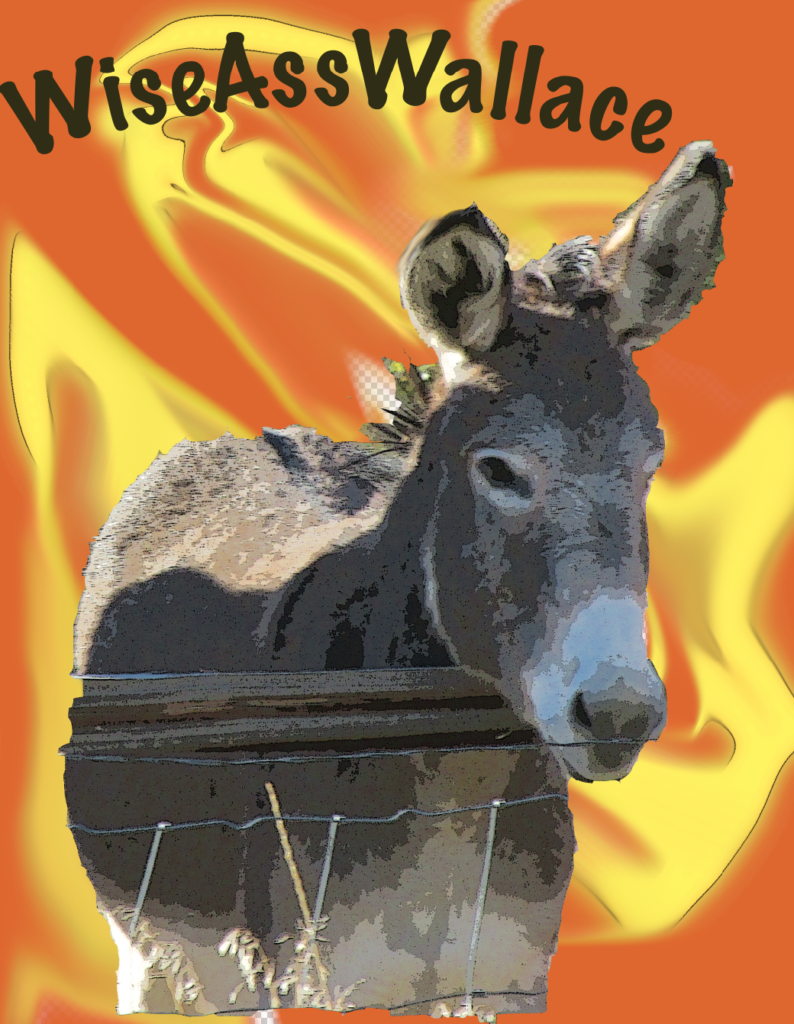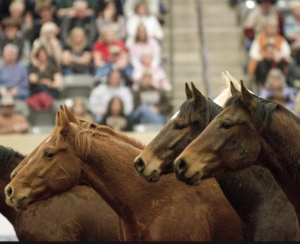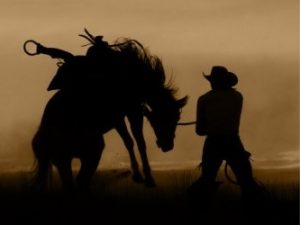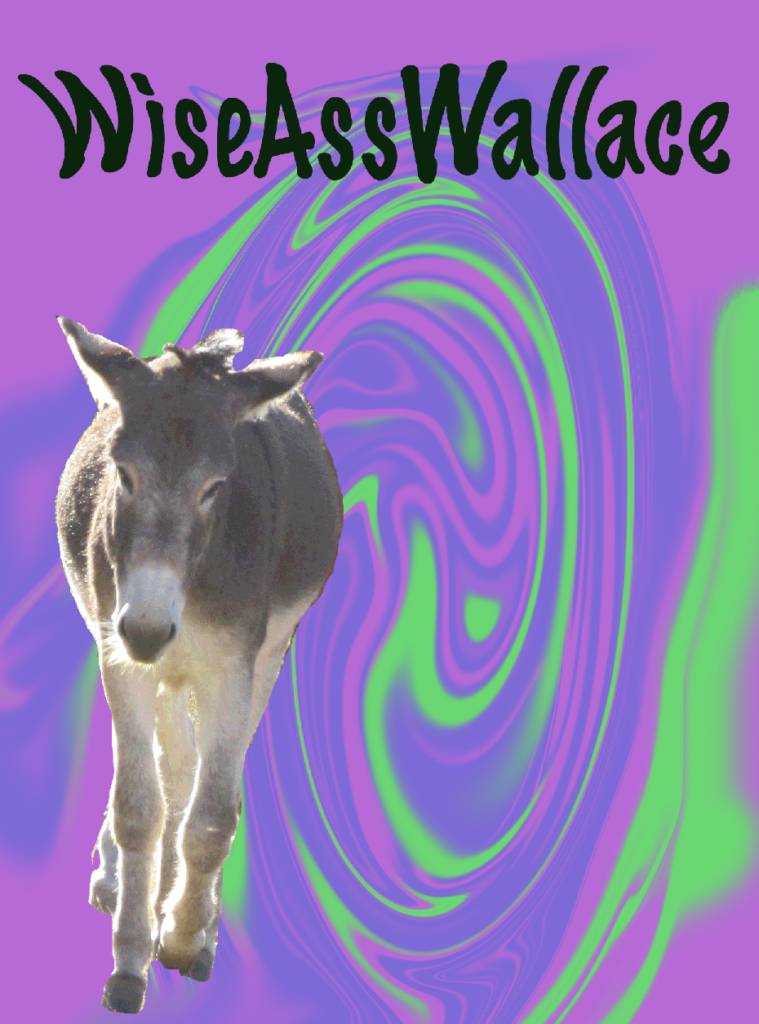 Editor’s Note: WiseAssWallace is a beloved guest columnist for Cayuse Communications. From his Colorado pasture, he’s on a quest to improve horse-human connections and make lives better for his fellow equines. In this latest installment, WAW weighs in on colt-starting competitions. Read more from WiseAssWallace here.
Editor’s Note: WiseAssWallace is a beloved guest columnist for Cayuse Communications. From his Colorado pasture, he’s on a quest to improve horse-human connections and make lives better for his fellow equines. In this latest installment, WAW weighs in on colt-starting competitions. Read more from WiseAssWallace here.
WiseAssWallace writes:
It’s that time of year again, folks. Call it My Season of Discontent.
Why?
Because of colt-starting competitions, of course.
Don’t let them fool you into thinking this is a good deal for the horses. It ain’t.
What I see here is double shots of showmanship and ego with only a salt shake of actual horsemanship. Show-off-manship is more like it. Even with good trainers in the mix, their work is soured, squandered, in fact, by the ill-witted incentive and misplaced motivation to git-er-done with fireworks and fanfare. There’s money and accolades for the human. What’s in it for the horse? Nuthin’ but confusion, stress, and a wholly horrible start.
You might find these Highway to the Horse events entertaining, but let me present them from our equine perspective, in a way you might understand:
 Consider, if you will, a trip to the dentist, or, driving on a four-lane highway in rush-hour traffic. You would not relish these experiences. Am I right?
Consider, if you will, a trip to the dentist, or, driving on a four-lane highway in rush-hour traffic. You would not relish these experiences. Am I right?
— The dentist will put you in uncomfortable, vulnerable positions.
— Rush-hour driving will force you to make quick, stressful decisions.
Good times, they are not.
Of course, these scenarios would be more manageable if you had some decent experiences leading up to them:
— like your mom takes you to a children’s dentist with a cool aquarium in the waiting room and when you sit in the chair at each visit, there’s a television showing cartoons on the ceiling, bubble-gum flavored fluoride, and a free toothbrush at the end. What a deal!
— like you spend time driving on gravel backroads, learning how to shift, brake, and turn with the summer breeze blowing through your hair, and then you get to practice going fast and passing on a two-lane state highway.

Happy and relaxed, WAW doesn’t think so
But noooo, colt starting competitions aren’t about proper preparation or building on good experiences. In fact, they are specifically geared to highlight the freakouts us equines will inevitably have as we are put in sketchy, involuntary, and compromised positions.
Believe me. I’ve had to counsel many a horse who’s come to our pasture after being run through the gauntlet of a Highway to the Horse. They are damaged compadres, sorry to say.
What else would you expect?
Again, consider our perspective. Take a fresh, young horse who’s been hanging out with buddies, minding his own business, then put him under the lights, with frenetic crowds and loud speakers.
Dang, just this setup would set me on edge!
But noooo, we’re going to introduce you, Young Horse, to a human who aims to halter and saddle you in a matter of hours. Not shocking enough to the system? Let’s see how you handle it when this human snaps bullwhips and stands up in the saddle. Having fun yet, Flicka?
 Would you like a root canal on your very first dental visit?
Would you like a root canal on your very first dental visit?
How would you manage that four-lane, rush-hour drive before you even have your license?
After they’ve been “started” like this, my pasture friends have issues. I call them Highway of the Horse Hangovers:
-
- They’re shutdown. They learned that if they submit, things will be easier. During the course of the event, they go from sweaty and worried to sweaty and listless. It takes a smart, kind, patient human to bring the life back in their mind and body.
- Their foundation is as fragile and frail as Little Piggie’s stick house. When asked to step up and, say, be a productive ranch horse or a reliable trail horse, these equines either overreact or check out. It takes a smart, kind, patient human to rebuild their confidence, mental and physical abilities.
So why not skip the next Highway to the Horse? There might be winners but horses ain’t among them. It might be fun, but not for us.
WiseAssWallace would like to thank horsemen Amy Skinner, Kyla Strange, Steve Peters, and Mark Rashid for their input.
I like those mustang starting events where someone gets to take their horse home and work with them for a number of months and return to show how giving the horse time and good training has helped them to adjust.
Right away I developed a bad taste in mouth when I watched young horses being put under pressure in a circus atmosphere. Im not even sure that it is ethical to give the general public the idea that that is the best way to offer your horse a good training situation. Many of them just check out.
I am also somewhat surprised to see trainers that actually disagree with the whole idea sell out and get involved for money and recognition. It is no fun to watch a horse become “flooded” and given little to no time to process the experience. Thanks to your donkey for bringing to light what is rarely criticized for what it is. A bad schooling start for the young horse at best.
I believe that a few of us have found ourselves trying to straighten out a horse that has been what we call “saddle raped” in some contest o by some showboater. A clever horseman can make a horse appear under control for a short period, but it doesn’t mean that horse isn’t damaged goods that has difficulty down the road or even get dumped as undesirable because its compliance in the contest was based on dominance, fear and avoidance to excessive pressure rather than allowing the horse to process the activity and actually find the right answer (i.e., learn.) One fundamental flaw I see is that most legitimate contests are based on the premise of having a relatively level playing field. Horses can be extremely diverse individuals displaying varying behavior models. Some may bore easily and actually flourish being fast tracked. Others may display fear or even aggression. I’ll leave it to Dr. Peters and Martin Black to explain the neurology, but horses as a species have such diverse emotions and responses that they make poor speed contest subjects. The “duh” factor is that they need to be presented with new challenges at a rate that is compatible with their respective processing speed.
The most dramatic example I can recall from back in the days that we did the Wild Horse Workshops (and it’s on video) was a BLM stud at the Tooelle, UT event. One BLM stud was just too dangerous for the participants to handle as he would charge, strike and kick. At the end of the day we had the “kicky stud” brought back into one of the training pens. We had turned a water tank upside down to make a table and put chairs around it. Frank Bell brought in a deck of cards and we sat down and played poker. I will admit that we used some alfalfa to place our bets. In a relatively short time the horse was working his way into the game. Clearly he was sizing us up ll the time but literally in just a few minutes he had pushed his way into the game. Robert Denlinger was seated on the horse’s “on side” and in a few minutes, when the horse was ready, Robert haltered the horse without leaving his chair.
If the comment form allows, here is a copy of the poker game video. Please note that the “Bud Light” cans were props for the film crew and contained water. Horse gentling and alcohol should never mix.
https://www.youtube.com/watch?v=0-eauilWAXk
Thanks SO MUCH for sharing this video! That’s real horsemanship! 👌👍
it is easy to get lured in to the excitement of it as a human . It is the same conversation I have with my daughter about the circus and some rodeo events. “once we have learned that there are better ways to communicate with animals why would we perpetuate the ideas of exploiting , scaring and “breaking” them? ” We cannot as lovers of animals encourage or support methods that hurt this connection. I applaud the people who in ads state that they took extra time to work with an animal giving them the space they need to form a partnership.
After reading Wallace’s words of wisdom, I was going to comment, but found the previous commenters had said about all there was to be said. Whenever we put an artificial timeframe on “teaching”, the result is rarely “learning.” Can one slap together a spectacle of conditioning that appears to meet the event’s specific requirements? Obviously, yes, but I would echo the previous submissions; I’ve had many, many horses brought to me for tuneup or finishing that have been same-day, two-week, or thirty-day wonders. Invariably, I’ve been compelled to explain to the owner that their horses were never really started; someone simply stole a ride on them, and they need to be brought along with more patience and greater sensitivity if what they want is a partner. This often precipitates an argument that Famous Trainer X did the work, therefore my evaluation MUST be erroneous. But the proof is always blatantly obvious, otherwise, they wouldn’t have needed to bring the horse to someone else. More and more, I’m finding support from science for my contention that when it comes to teaching, it takes as long as the horse says it takes, which varies from individual to individual, and can’t be made to fit into some promoter’s or hotshot clinician’s arbitrary deadline.
At many venues, these “colt starting exhibitions” have become a competition between showmen, one is selected to be the “winner” and gets a prize. Since when has training a horse become a competitive sport? Horses subjected to this experience are not “broke”. They have allowed a human to sit on it’s back, but there is a huge difference between that, and “broke”. And the general public and green horse owners watch this, and think that “this looks easy, I can do this at home with MY horse”. This is not helpful, to the owner, or the horse. I can’t even watch these exhibitions, makes me sick. I watched Monty Roberts do one decades ago, and found it a good exhibition of successful communication with a green horse, and the rider was sitting on the horse and going around a round pen at w/t/c after half an hour, without a lot of stress. But that is not “broke”. And there may well be reasons why professional trainers may want to do this, but it still takes a month at least before the horse could be considered “green broke”, and still only suitable for an experienced and skilled rider to ride. So overall, the time it takes is the same, no matter what road you take, putting the rider on right away or working on the ground without riding right away. What I like about taking “longer” to get onto a horse is that the repetition of lessons allows the horse to become fitter before being asked to carry weight, which IMO, keeps him sounder in the long run.
I sponsor Buck Brannaman’s 4 day Colt Starting Class in Carmel Valley. This year April 25-28. Good hands who’ve worked with Buck for years come from across the country to give these youngsters the best start possible under Buck’s watchful eye. If a colt does need to buck or squirts out, these riders have the where-with-all to pet and support instead of hanging on for dear life or worse “yahooing” the unsure youngster. A good 90% of the time with the colts is spent on ground-work. Maybe not the thrills and chills of contests but a treasure trove of essential information for anyone who desires to give their horse the best deal possible. Auditors welcome. All questions answered .
Bonnie, excellent description of an appropriate contrast. Properly supervised events such as Buck’s can typically generate positive outcomes. Speed contests should be relegated to dirt bikes and hot rods.
Agree 💯 with you. Go check out Bill Oliver. He is by far the BEST clinician on colt starting. He refuses to do the road to the horse. He believes it is NOT good for the horse. Thanks for your insight